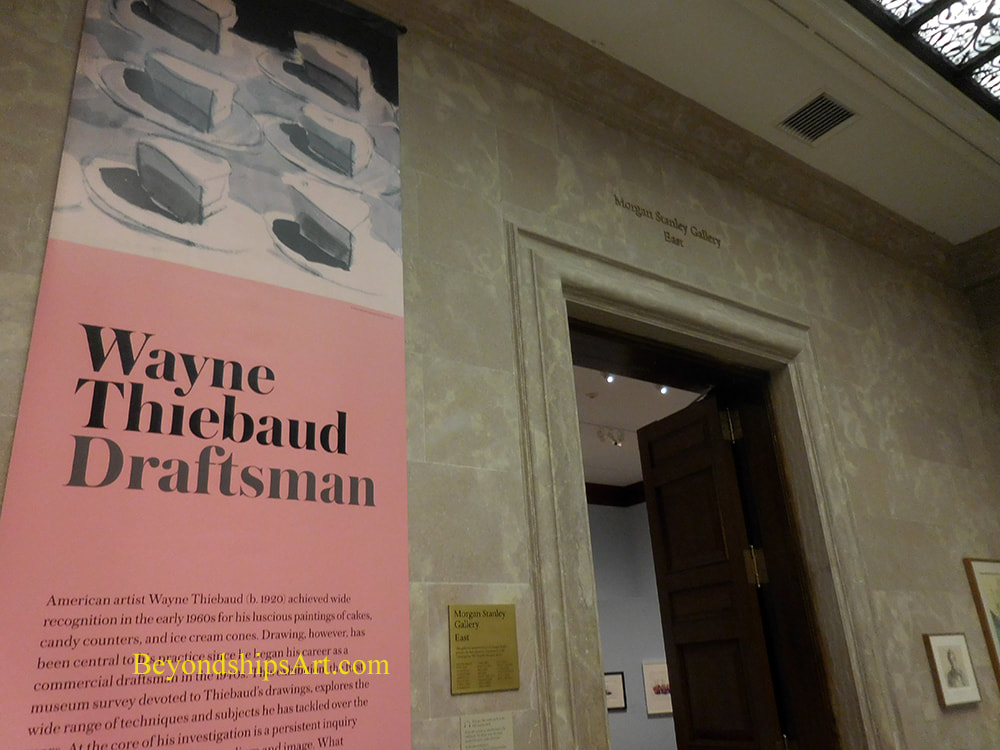"Wayne Thiebaud Draftsman" In some 85 works, including works on loan from the artist, “Wayne Thiebund Draftsman” at the Morgan Library and Museum looks at the importance of drawing in the work of a major contemporary painter.
Wayne Thiebund was born in Arizona in 1920 but grew up in Long Beach, California. Indeed, one of the jobs that he had in high school was working for the Walt Disney Studio as an apprentice cartoonist. After attending the Frank Wiggins Trade School, Thiebund worked as a commercial artist in California and in New York. During World War II, he was an artist for the Army Air Force. Following the war, Thiebund earned a bachelor's degree and a masters degrees from Sacramento State College. This led him to teaching art, first at Sacramento City College and then at the University of California Davis. Thiebund became interested in abstract expressionism and in the work of Willem de Kooning and Franz Kline. So he took a leave of absence from teaching and traveled to New York to learn about this type of art from the people who were producing it. He became friends with both de Kooning and Kline and for a time he tried his hand at abstract expressionism. However, de Kooning advised him not to imitate other artists but rather to produce his own style of art. Working as a commercial artist, Thiebund had become fascianted with the abstract patterns that appear in servings of food. He used to sketch the lines of cake servings and other food in stop windows. Combining this interest with the bright colors he had used as a cartoonist and the clear renderings that he had done as a commercial artist, Thiebund began to do paintings of food items and rows of food items such as you would see on a cafeteria counter or in a diner - - pies, cakes, hot dogs, hamburgers. This was the early 1960s and Pop Art exploded onto the art scene. In 1962, Thiebund's works were exhibited along with works of Andy Warhol, Roy Lichtenstein and other pop artists in a landmark exhibition at the Pasadena Art Museum. He did not consider himself a Pop arist, however. In Pop Art, everyday objects were given exaggerated importance as social commentary on the commercialization and materialism in western society. Thiebund's works were not meant as social criticism, he liked the shapes and the patterns. His works explored the effects of light and composition. He also had a positive attitude toward the food that he depicted. “I'm not a card-carrying Pop artist,” he has said. Even after becoming a successful artist, Thiebund continued to teach. He also continued to do paintings of food and everyday objects. However, he also expanded into landscape painting and paintings of figures. The exhibition at the Morgan shows that from his early days as an apprentice cartoonist drawing has served as a foundation for Thiebund's art. Furthermore, his time as a commercial artist helped to hone his skills as a draftsman, making his drawing more precise and efficient. We see this in a series of early drawings. We also see that Thiebund was influenced by great draftsmen of the past such as Degas and Daumier. Not only does Thiebund encourage his students to copy old master drawings but the exhibition shows us that he practices what he preaches. The exhibition also shows that drawing is not something separate and apart from the rest of Thiebund's work. Included in the works on paper are pictures of foodstuff, landscapes and figures - - the same subjects as his paintings. Drawing can be used to work out ideas and to develop compositions or it can be used to create a finished work. |
|
Art review - Morgan Library and Museum - "Wayne Thiebaud Draftsman"
